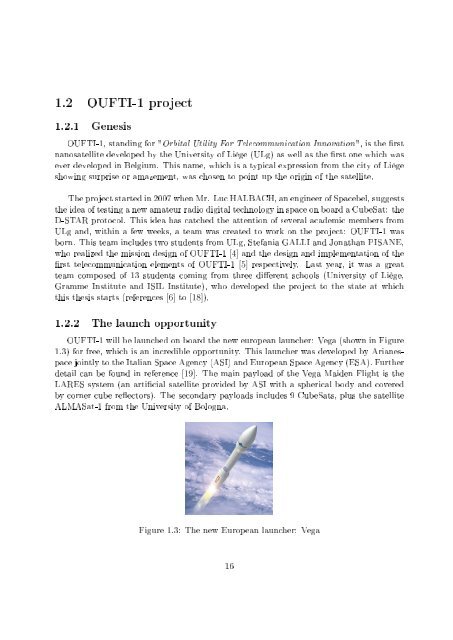Master Thesis - OUFTI-1
Master Thesis - OUFTI-1
Master Thesis - OUFTI-1
Create successful ePaper yourself
Turn your PDF publications into a flip-book with our unique Google optimized e-Paper software.
1.2 <strong>OUFTI</strong>-1 project<br />
1.2.1 Genesis<br />
<strong>OUFTI</strong>-1, standing for "Orbital Utility For Telecommunication Innovation ", is the rst<br />
nanosatellite developed by the University of Liège (ULg) as well as the rst one which was<br />
ever developed in Belgium. This name, which is a typical expression from the city of Liège<br />
showing surprise or amazement, was chosen to point up the origin of the satellite.<br />
The project started in 2007 when Mr. Luc HALBACH, an engineer of Spacebel, suggests<br />
the idea of testing a new amateur radio digital technology in space on board a CubeSat: the<br />
D-STAR protocol. This idea has catched the attention of several academic members from<br />
ULg and, within a few weeks, a team was created to work on the project: <strong>OUFTI</strong>-1 was<br />
born. This team includes two students from ULg, Stefania GALLI and Jonathan PISANE,<br />
who realized the mission design of <strong>OUFTI</strong>-1 [4] and the design and implementation of the<br />
rst telecommunication elements of <strong>OUFTI</strong>-1 [5] respectively. Last year, it was a great<br />
team composed of 13 students coming from three dierent schools (University of Liège,<br />
Gramme Institute and ISIL Institute), who developed the project to the state at which<br />
this thesis starts (references [6] to [18]).<br />
1.2.2 The launch opportunity<br />
<strong>OUFTI</strong>-1 will be launched on board the new european launcher: Vega (shown in Figure<br />
1.3) for free, which is an incredible opportunity. This launcher was developed by Arianespace<br />
jointly to the Italian Space Agency (ASI) and European Space Agency (ESA). Further<br />
detail can be found in reference [19]. The main payload of the Vega Maiden Flight is the<br />
LARES system (an articial satellite provided by ASI with a spherical body and covered<br />
by corner cube reectors). The secondary payloads includes 9 CubeSats, plus the satellite<br />
ALMASat-1 from the University of Bologna.<br />
Figure 1.3: The new European launcher: Vega<br />
16












